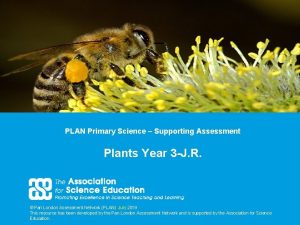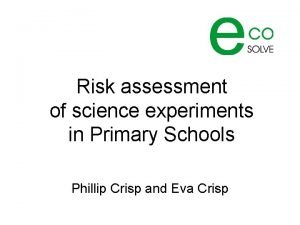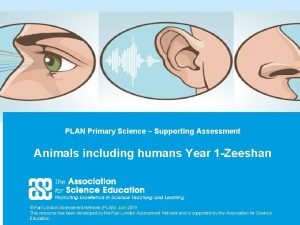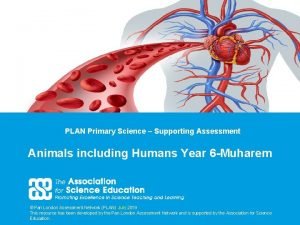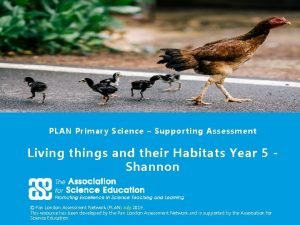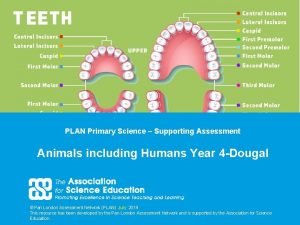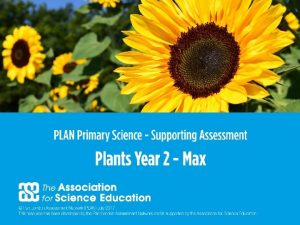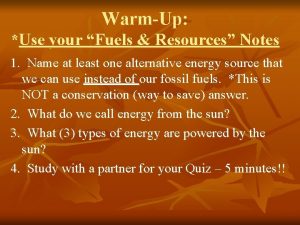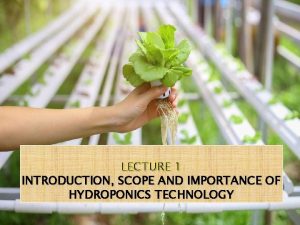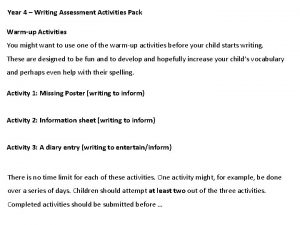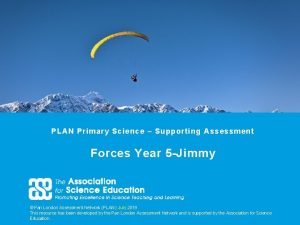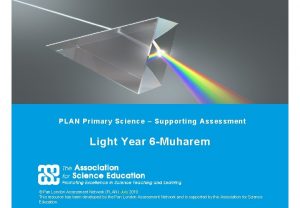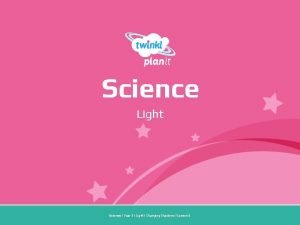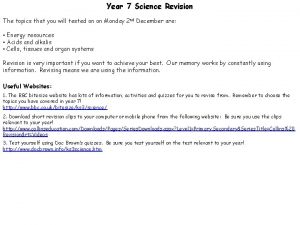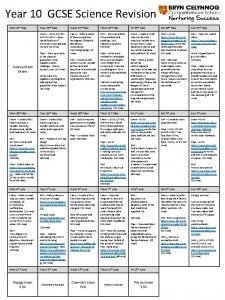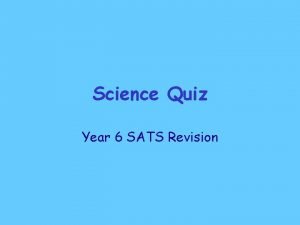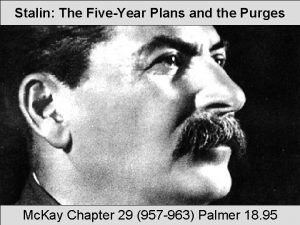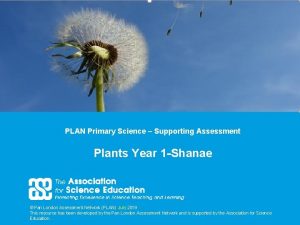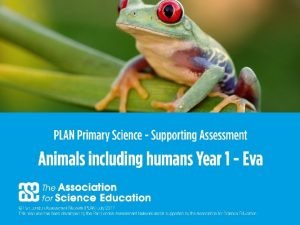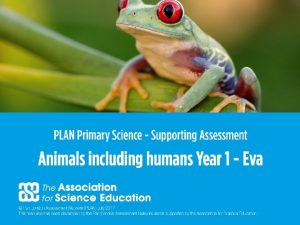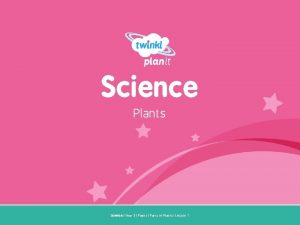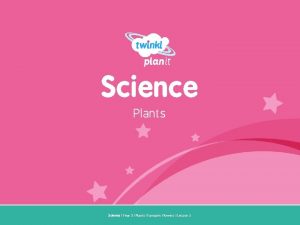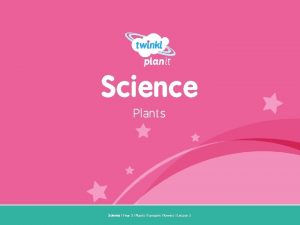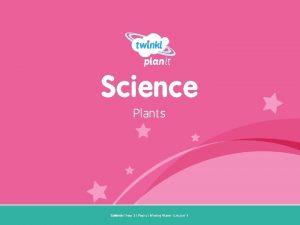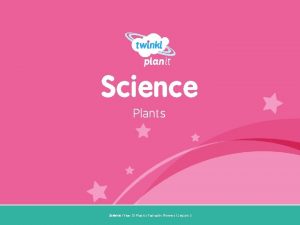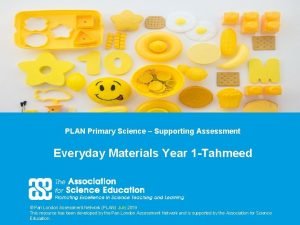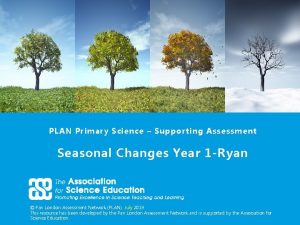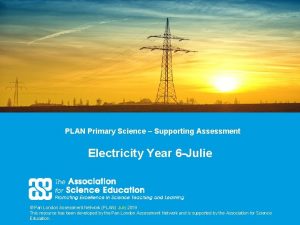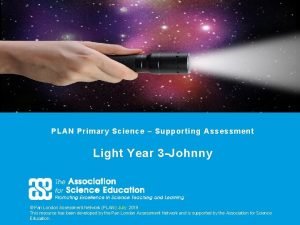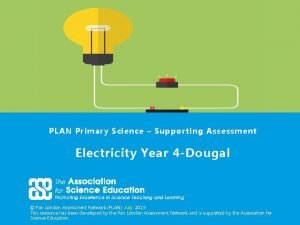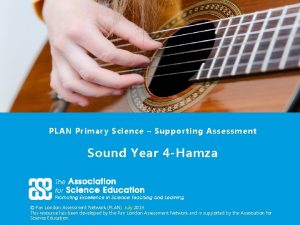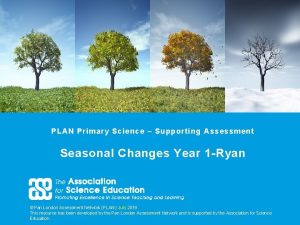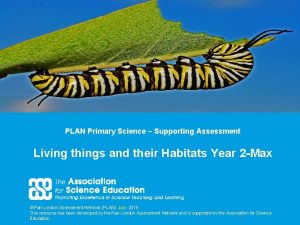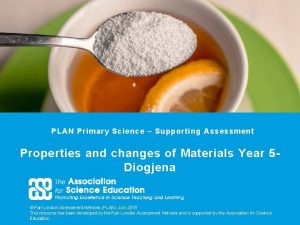PLAN Primary Science Supporting Assessment Plants Year 3





































- Slides: 37

PLAN Primary Science – Supporting Assessment Plants Year 3 -J. R. © Pan London Assessment Network (PLAN) July 2019 This resource has been developed by the Pan London Assessment Network and is supported by the Association for Science Education. 1

PLAN Primary Science - Supporting Assessment PLAN Primary Science is a set of resources produced to enable teachers to have a clearer understanding of National Curriculum expectations for meeting the standard. Annotated collections of children’s work provide examples of what working at the expected standard for primary science might look like for the knowledge and conceptual understanding statements of the programmes of study (POS). It is not the intention of these resources to specifically exemplify the working scientifically statements. However, aspects of working scientifically have been shown as an integral part of the teaching and learning of the knowledge and concepts. The resources provided have been cross moderated multiple times before publishing so that they can be used with confidence by teachers and subject leaders. Each collection of work shows one example of how a pupil has met National Curriculum statements for a particular area of content but these are not intended to be the definitive way of teaching these statements. 2

Structure of the resources Each resource contains the relevant National Curriculum statements for the unit of work and prior learning, a planning matrix, annotated work and a summary sheet. The matrix provides an interpretation of the key learning of the National Curriculum statements, and suggestions of key vocabulary. In order to be meet the expectations pupils must firstly understand the key concept and then be provided with opportunities to apply that knowledge. This is a key planning tool. Key Learning Secure Possible Evidence Show Overview paragraph describing understanding of a curriculum concept by using scientific Key vocabulary – list of words vocabulary correctly Possible ways to demonstrate key learning, particularly correct usage of vocabulary Apply knowledge in familiar related contexts Possible ways to demonstrate that a pupil has gone beyond recall of facts and can apply the key learning, for example using the vocabulary and basic principles to produce explanations, usually within Working Scientifically contexts. Suggestions of contexts to use. 3

Contents of the materials Please note: The NC statements for each topic area for the relevant year group are stated on the slide. Only the statements in bold on that slide have been exemplified. In these cases the teachers have chosen to split the statements within the topic area to teach at different times. The prior NC statements relevant to the topic area are also stated and use to determine pupils’ knowledge at the start of the unit. Each slide has been annotated with coloured text. Please see key below: Red statements Blue Commentary to explain how evidence meets/does not meet NC Commentary to highlight features of working scientifically Green Pupil Speak Grey Other relevant information eg. vocabulary used 4

Prior Learning Year 1 statements Pupils should be taught to: • identify and name a variety of common wild and garden plants, including deciduous and evergreen trees (1 -Plants) • identify and describe the basic structure of a variety of common flowering plants, including trees (1 -Plants) 5

Prior Learning Year 2 statements Pupils should be taught to: • observe and describe how seeds and bulbs grow into mature plants (2 -Plants) • find out and describe how plants need water, light and a suitable temperature to grow and stay healthy (2 -Plants) 6

Year 3 statements Pupils should be taught to: • identify and describe the functions of different parts of flowering plants: roots, stem/trunk, leaves and flowers (3 -Plants) • explore the requirements of plants for life and growth (air, light, water, nutrients from soil, and room to grow) and how they vary from plant to plant (3 -Plants) • investigate the way in which water is transported within plants (3 -Plants) • explore the part that flowers play in the life cycle of flowering plants, including pollination, seed formation and seed dispersal (3 -Plants) 7

Later Statement Pupils do not need to be taught content they will learn in later year groups. They can be challenged by applying the content for their year group in broader contexts. Pupils in Year 5 will be taught to: • describe the life process of reproduction in some plants and animals (5 -Plants)

SECURE Assessment guidance Key learning Possible Evidence Shows understanding of a Many plants, but not all, have roots, stems/trunks, leaves and flowers/blossom. The roots absorb water and nutrients from the concept using scientific soil and anchor the plant in place. The stem transports water and vocabulary correctly nutrients/minerals around the plant and holds the leaves and flowers up in the air to enhance photosynthesis, pollination and seed dispersal. The leaves use sunlight and water to produce the plant’s food. Some plants produce flowers which enable the plant to reproduce. Pollen, which is produced by the male part of the flower, is transferred to the female part of other flowers (pollination). This forms seeds, sometimes contained in berries or fruits which are then dispersed in different ways. Different plants require different conditions for germination and growth Key vocabulary Photosynthesis, pollen, insect/wind pollination, seed formation, seed dispersal – wind dispersal, animal dispersal, water dispersal Can explain the function of the parts of a flowering plant Can describe the life cycle of flowering plants, including pollination, seed formation, seed dispersal, and germination Can give different methods of pollination and seed dispersal, including examples Applying knowledge in familiar related contexts, including a range of enquiries Can explain observations made during investigations Can look at the features of seeds to decide on their method of dispersal Can draw and label a diagram of their created flowering plant to show its parts, their role and the method of pollination and seed dispersal Observe what happens to plants over time when the leaves or roots are removed Observe the effect of putting cut white carnations or celery in coloured water Investigate what happens to plants when they are put in different conditions e. g. in darkness, in the cold, deprived of air, different types of soil, different fertilisers, varying amount of space Spot flowers, seeds, berries and fruits outside throughout the year Observe flowers carefully to identify the pollen Observe flowers being visited by pollinators e. g. bees and butterflies in the summer Observe seeds being blown from the trees e. g. sycamore seeds Research different types of seed dispersal Classify seeds in a range of ways including by how they are dispersed

Assessing prior knowledge The children were taken outside and asked to find as many different plants as they could. They took photos of these so that they could talk about them back in the classroom. Following on from this the children completed the first two columns of the KWL grid This is learning from year 2. Year 3 learning, but focusses on the flower. This shows an awareness that plants vary (year 1 learning) This question indicates that J. R. is not secure on the year 2 objective about bulbs and seeds This part will be completed at the end of the topic to show learning. 10

Researching and sharing the function of a part of the plant • identify and describe the functions of different parts of flowering plants: roots, stem/trunk, leaves and flowers In groups of four each child was nominated a part of the plant. They used secondary sources to find out the function of this part of the plant. They explained this to the rest of their group, highlighting the key scientific vocabulary. The children then recorded what they had learnt about the four parts of the plant. J. R. is aware of the main functions of the parts of a plant but has not yet investigated how these are performed. 11

Consolidating knowledge through actions • identify and describe the functions of different parts of flowering plants: roots, stem/trunk, leaves and flowers The children watched the video of the parts of a plant song and acted it out in groups. https: //www. youtube. com/watch? v=ql 6 OL 7_q. Fg. U There is a video of JRs group acting out the song. https: //drive. google. com/file/d/0 Bw. UO 9 Ua. Qu. RDa. LVh 6 NURC RWRza. VE/view 12

Observing a dying plant • explore the requirements of plants for life and growth (air, light, water, nutrients from soil, and room to grow) and how they vary from plant to plant The teacher showed the children a plant he had brought in from home that was dying and asked the children to discuss what he may have done wrong. The soil is very dry. Have you not been watering it? Maybe it is too hot. Do you think it is getting enough light? This discussion supported the children to identify what plants need to stay healthy and grow. There is confusion here J. R. is aware of some of the needs of a plant for growth. This needs to be developed further and investigated. The distinction between air, oxygen and carbon dioxide is not required in KS 2 13

Investigating conditions needed for life and growth • explore the requirements of plants for life and growth (air, light, water, nutrients from soil, and room to grow) and how they vary from plant to plant The children, working in 5 groups, planned investigations to test their ideas about what a plant needs. Each group was given the same type of mature plant, grown from a bulb, and decided how to deprive it of one of the requirements. There was class control which had all the requirements. J. R. ’s group tested whether their plant needed soil by placing it in the neck of a plastic cylinder with the roots and part of the bulb in the water. J. R. recognises that the water is more important than the soil. He is still confusing about the difference between the water and the nutrients from the soil that are dissolved in it. J. R. uses his knowledge of plants to make a prediction. 14

Investigating conditions needed for life and growth (continued) • explore the requirements of plants for life and growth (air, light, water, nutrients from soil, and room to grow) and how they vary from plant to plant The requirements that the class suggested were soil, light, warmth, water and air. A reference to the cylinder being similar to the pots the other plants were in J. R. understands that different variables are being investigated across the class and that each group is changing only one thing. He identifies some control variables and, when prompted, his group’s independent variable. 15

Investigating conditions needed for life and growth (continued) • explore the requirements of plants for life and growth (air, light, water, nutrients from soil, and room to grow) and how they vary from plant to plant JR recorded observations and measurements on a prepared table. 16

Investigating conditions needed for life and growth (continued) • explore the requirements of plants for life and growth (air, light, water, nutrients from soil, and room to grow) and how they vary from plant to plant This is the results table for the group that did not water their plant. JR used data from other groups to compare the effect of different conditions. 17

Investigating conditions needed for life and growth (continued) • explore the requirements of plants for life and growth (air, light, water, nutrients from soil, and room to grow) and how they vary from plant to plant Each group compared their plant with the control and with those of the other groups. All of the plants were unhealthy compared with the control but J. R. decided that the plant which had been deprived of light was the least healthy. The one which had not been watered looked healthiest J. R. knows all the plant requirements except for room to grow, which was not investigated. He is not yet secure in his understanding of the function of the leaf and does not explain why sunlight is important for plants Although not very clearly expressed, J. R. ’s conclusion is consistent with the data as his plant was in a worse condition than the one without water at the end of the investigation. 18

Researching conditions needed for life and growth • explore the requirements of plants for life and growth (air, light, water, nutrients from soil, and room to grow) and how they vary from plant to plant Stimulated by a cactus in class, the children undertook their own research, using laptops, as to why and how plants’ needs vary. They created a poster. J. R. has identified how plants are adapted to habitats with varying amounts of light, water and soil

Researching further about the function of the leaves • identify and describe the functions of different parts of flowering plants: roots, stem/trunk, leaves and flowers The children were given a range of web links to explore to learn more about the role of the leaf. J. R. has drawn on his knowledge of healthy eating to describe the food made by the leaves as nutrients. He now knows the function of the leaves of a plant. 20

Investigating whether soil type affects plant growth • explore the requirements of plants for life and growth (air, light, water, nutrients from soil, and room to grow) and how they vary from plant to plant To link in with learning about soils the children were presented with five types of soil to observe closely and were then asked to think how the different soils might affect plant growth. J. R. makes careful observations of the soils which he presents using annotated diagrams. J. R now shows a secure understanding of the role of the roots in providing the plant with water and nutrients whilst also holding it in place in the ground. 21

Investigating whether soil type affects plant growth (contd. ) • explore the requirements of plants for life and growth (air, light, water, nutrients from soil, and room to grow) and how they vary from plant to plant After a number of days the children observed the plants and drew conclusions from their observations. J. R. shows understanding that the soil provides nutrients and that organic matter is important. He also understands that the texture of the soil may affect whether the plant is able to grow through it. 22

Demonstrating water transportation through the stem • investigate the way in which water is transported within plants The teacher showed carnations and food colouring to the children and reminded them about their research into the function of the stem. He asked them how they might use these resources to see the water within the plants and to demonstrate that the stem transports water to other parts of the plant. The teacher then set up the demonstration and the children observed that the flowers turned blue. I think that if we put the white flowers in the blue water it will go up the stem and make the stem go blue and then the flower. J. R. uses his knowledge of the function of the stem to make a prediction. 23

Investigating the rate of transportation of water • investigate the way in which water is transported within plants The children were then asked to think about what might make the water be transported more or less quickly. They decided that the whole class would investigate the effect of temperature. If the stem is long it will take longer to reach the flower. If it is hotter, it may change colour more quickly. It may be different for different flowers. Can we add to the prediction - so the flower in the warm will go blue first. J. R. suggests possible variables to be investigated and makes a logical prediction for the chosen variable. J. R. has identified a number of variables that need to be controlled. 24

Investigating the rate of transportation of water (continued) • investigate the way in which water is transported within plants The children made observations of the carnations at the start then added the dye and put one in a cold and one in a warm location. J. R. made observations and recorded them on a prepared table. 25

Investigating the rate of transportation of water (continued) • investigate the way in which water is transported within plants They then drew conclusions from the data and drew diagrams to show water is transported in a growing plant. J. R. uses his observations to draw a conclusion. He does not refer to the colour change in the stem of the cold plant. The class have not been taught about evaporation but he picked this up from the research into leaves. Further evidence that J. R. knows the role of the stem and roots. J. R. has now consistently demonstrated that he understands how water is transported within a plant and the role of roots and the stem in this. 26

Research into the life cycle of flowering plants • explore the part that flowers play in the life cycle of flowering plants, including pollination, seed formation and seed dispersal Following a group research activity the children drew what they had learned about the life cycle of a flowering plant. J. R. includes the key vocabulary – germinate, pollen, pollination, seed formation, seed dispersal J. R has not yet included how flowers are pollinated or the types of seed dispersal. 27

Observing flowers • explore the part that flowers play in the life cycle of flowering plants, including pollination, seed formation and seed dispersal The children made further observations of plants in the school grounds focusing on the flowers. There are bees on the flowers. They must be pollinating them. Then they discussed cut flowers in the classroom I can see the stamens where the pollen is and the bit where it has to land. They stick out a long way so I think this one is wind pollinated J. R is now developing his understanding of how flowers are pollinated. 28

Extended writing to consolidate learning • explore the part that flowers play in the life cycle of flowering plants, including pollination, seed formation and seed dispersal During an English lesson the children were asked to write a diary entry from the perspective of a bee, including their scientific understanding about the life cycle of a flowering plant. This piece of creative writing demonstrates a secure understanding of pollination. Some confusion regarding seed dispersal and seed formation which is clarified by the follow up question. 29

Researching seed dispersal • explore the part that flowers play in the life cycle of flowering plants, including pollination, seed formation and seed dispersal The children were asked to carry out and present some initial research into how seeds are dispersed. JR knows some ways in which seeds are dispersed although his drawings do not show good understanding of this stage of the lifecycle. He knows why plants need to produce seeds but not why dispersal is important What do you mean, to give more oxygen? We need more plants to put more oxygen in the air. 30

Sorting seeds • explore the part that flowers play in the life cycle of flowering plants, including pollination, seed formation and seed dispersal After looking at a selection of seeds the children sorted pictures of different types of seeds and explained why they are suited to certain types of seed dispersal. JR has extended his knowledge of methods of seed dispersal and can identify seeds which are dispersed in different ways. He now knows that plants need room to grow and can give a reason why seed dispersal is important.

Extended writing to consolidate learning • identify and describe the functions of different parts of flowering plants: roots, stem/trunk, leaves and flowers • explore the requirements of plants for life and growth (air, light, water, nutrients from soil, and room to grow) and how they vary from plant to plant • explore the part that flowers play in the life cycle of flowering plants, including pollination, seed formation and seed dispersal J. R. describes the life cycle of a flowering plant, names plant parts and identifies the function of the flower 32

Extended writing (continued) J. R. describes most of the requirements of a plant for life and growth linked with explanations of the functions of leaves and roots. The term chlorophyll is not needed at this stage The distinction between the need for carbon dioxide from the air for photosynthesis and oxygen for respiration is not needed at this stage. 33

Extended writing (continued) In the last paragraph J. R. describes the function of the stem. The whole piece of writing is a good summary of J. R. ’s learning about the function of the parts of plants, the conditions for growth and also the life cycle of a flowering plant including types of seed dispersal. 34

Final additions to KWL From his observations of growing plants from bulbs in different conditions J. R. now knows what bulbs are J. R. includes information about conditions needed for growth and the function of the leaves. 35

Overall Summary Secure They are able to identify and describe the functions of different parts of flowering plants: roots, stem/trunk, leaves and flowers. The can explore the requirements of plants for life and growth (air, light, water, nutrients from soil, and room to grow) and how they vary from plant to plant, as well as investigating the way in which water is transported within plants. They also explores the part that flowers play in the life cycle of flowering plants, including pollination, seed formation and seed dispersal. 36

Acknowledgements Plant parts song from Harry Kindergarten Music www. harrykindergartenmusic. com Work for this unit was kindly funded through RSC funding for PSQM hubs 37
 Plants year 3 science
Plants year 3 science Risk assessment for science experiments
Risk assessment for science experiments Plan primary science
Plan primary science Plan primary science
Plan primary science Plan primary science
Plan primary science Plan primary science
Plan primary science Plan primary science
Plan primary science What's your favourite school
What's your favourite school What non vascular plants
What non vascular plants Non vascular plant reproduction
Non vascular plant reproduction Classification of flowering and non flowering plants
Classification of flowering and non flowering plants Photosynthesis equation
Photosynthesis equation Primary and supporting instruments
Primary and supporting instruments Instrument cross check
Instrument cross check Farmer plants different crops in a field each year
Farmer plants different crops in a field each year Leaving primary school poems
Leaving primary school poems Shoot system
Shoot system Primary growth and secondary growth in plants
Primary growth and secondary growth in plants Vascular ray
Vascular ray Hydroponics is the science of growing terrestrial plants in
Hydroponics is the science of growing terrestrial plants in Writing assessment
Writing assessment Friction concept cartoon
Friction concept cartoon Light assessment year 6
Light assessment year 6 Year 3 light
Year 3 light Year 7 science revision
Year 7 science revision Switched on science year 4
Switched on science year 4 Year 10 science revision
Year 10 science revision Keeping healthy quiz
Keeping healthy quiz Calvin goddard contribution to forensic science
Calvin goddard contribution to forensic science Yellow magenta and cyan are the ___
Yellow magenta and cyan are the ___ What was stalins goal
What was stalins goal 10 year plan assignment
10 year plan assignment What was stalins 5 year plan
What was stalins 5 year plan Collectivization
Collectivization Mathtv
Mathtv Chadha committee
Chadha committee Ghana vision 2020
Ghana vision 2020 Eleventh 5 year plan
Eleventh 5 year plan
